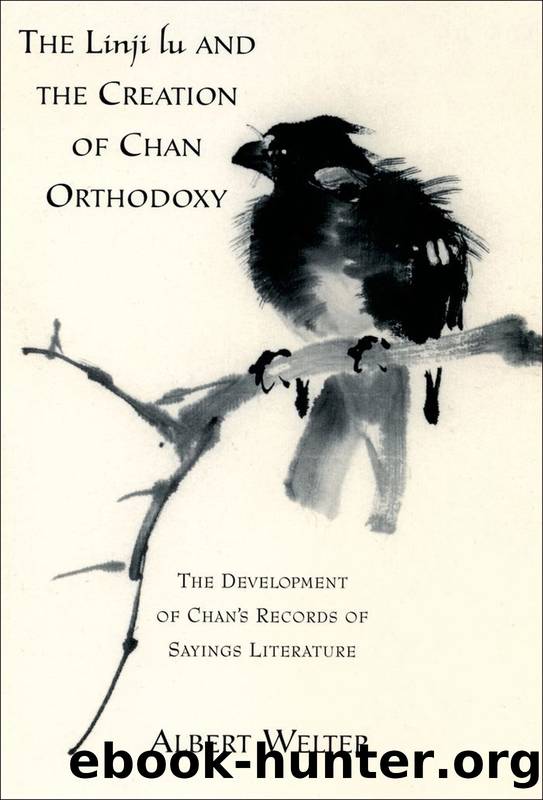The Linji Lu and the Creation of Chan Orthodoxy by Albert Welter;

Author:Albert Welter;
Language: eng
Format: epub
Publisher: Oxford University Press USA
Published: 2008-06-15T00:00:00+00:00
A Comparison of the Contents of the Linji lu: Guangdeng lu (GDL 10 and 11) and Zhenzhou Linji Huizhao Chanshi yulu (LJYL)
As mentioned previously, the first complete edition of the Linji lu was not the standard version, Zhenzhou Linji Huizhao Chanshi yulu,43 but the version included in fascicles 10 and 11 of the Tiansheng Guangdeng lu.44 While there are few differences in the actual contents recorded between the two versions, there are substantial differences in the order that the contents are recorded. (For a comparison of the Guangdeng lu version with that of the Linji Huizhao Chanshi yulu, see appendix 4.1.)
What do the different orders of the contents of the Linji lu tell us about the motives of their compilers? Whereas the LJYL is divided by subheadings into sections, Dharma Hall Sermons (shangtang ), Instructing the Assembly (shizhong ), Investigating and Assessing (kanbian ), and Record of Activities (xinglu ), no explicit sections are provided in the GDL.45 One of the most striking differences in the ordering of the contents is the way each version begins. Following brief biographical details, the GDL version begins with a series of episodes involving Linjiâs relationship with Huangbo Xiyun, whereas the LJYL version opens with lectures given by Linji at the request of the Prefect Governor (fuzhu ) and other officials. In the LJYL, biographical details regarding Linjiâhis origins in the city of Nanhua in Caozhou , his family name Xing , his exceptional brilliance as a child, and so onâappear at the end of the text in a greatly expanded fashion (discussed below).
The alternate arrangement of the textâs contents is instructive. By placing episodes detailing Linjiâs relationship with Huangbo first, especially the critical episode at the outset determining Linjiâs primary allegiance of Huangbo over Dayu, the GDL is weighing in on Linjiâs Dharma affiliation. Making Huangbo Linjiâs primary teacher was the claim of Linji faction affiliates in the early Song dynasty. It was done so to strengthen their claim to authority as the orthodox interpretation of Chan by linking Linji to the most illustrious representatives of the so-called Hongzhou faction: Mazu Daoyi Baizhang Huaihai and Huangbo Xiyun The assertion of this claim is implicit in the GDL ordering of the records of these four masters in sequential order: fascicle 8 (Mazu, Baizhang, and Huangbo), fascicle 9 (Baizhang), fascicles 10 and 11 (Linji).46 The implicit claim of the GDL is rendered explicitly in the Sijia yulu (Dialogue Records of Four Masters), compiled by Linji faction master Huanglong Huinan (1002â1069). The GDL and Sijia yulu claims rendered the Song dynasty Linji faction as true heirs to the legacy of Chan orthodoxy inspired by Mazu and the Tang dynasty Hongzhou faction. By placing Linjiâs crucial episodes with Huangbo in the final xinglu section of the text, the LJYL reflects a lessened concern in Chan circles over Linjiâs lineage affiliation.
When the LJYL was issued later in the Song, Linjiâs reputation as the founder of Chanâs major faction was assured. Linji stood as a major Chan figure, the founder of an illustrious lineage, and did not need to remain in the protective shadow cast by Mazu.
Download
This site does not store any files on its server. We only index and link to content provided by other sites. Please contact the content providers to delete copyright contents if any and email us, we'll remove relevant links or contents immediately.
The Way of Zen by Alan W. Watts(6292)
Ego Is the Enemy by Ryan Holiday(4963)
The Art of Happiness by The Dalai Lama(3851)
The Book of Joy by Dalai Lama(3705)
Why Buddhism is True by Robert Wright(3290)
Spark Joy by Marie Kondo(3089)
Shift into Freedom by Loch Kelly(3031)
Happiness by Matthieu Ricard(2888)
A Monk's Guide to a Clean House and Mind by Shoukei Matsumoto(2786)
The Lost Art of Good Conversation by Sakyong Mipham(2443)
The Meaning of the Library by unknow(2390)
The Third Eye by T. Lobsang Rampa(2174)
The Unfettered Mind: Writings from a Zen Master to a Master Swordsman by Takuan Soho(2160)
Red Shambhala by Andrei Znamenski(2074)
Anthology by T J(2047)
The Diamond Cutter by Geshe Michael Roach(1957)
Thoughts Without A Thinker: Psychotherapy from a Buddhist Perspective by Epstein Mark(1899)
Advice Not Given by Mark Epstein(1766)
Twilight of Idols and Anti-Christ by Friedrich Nietzsche(1764)
